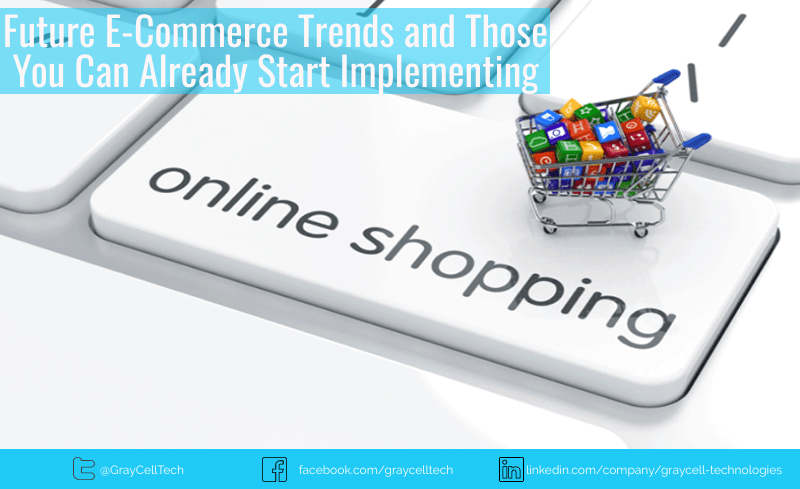E-commerce is experiencing continuous evolution and has revolutionized the retail industry significantly. This evolution is a vital requirement to meet the changing needs of people and make online shopping easier for them. The industry has seen steady growth in the last couple of years and doesn’t look like it is stopping anytime soon.
Speaking of its growth in recent years, a study, revealed that global e-commerce sales worth a whopping $3.453 trillion were made in 2019, and projected to even grow to $4.135 trillion in 2020. In 2021, the industry is expected to grow even further to hit the $4.878 trillion mark.
At the start of the e-commerce wave, it was fairly limited in its capabilities due to limiting technology. However, all of that seems to be changing now. These days, e-commerce is an integral part of our daily lives, and living without it can make life uncomfortable or even impossible. The industry is evolving in an attempt to influence the way that shoppers purchase products worldwide.
This evolution is down to an improvement in technology. And, with the improvement in user experience and safety, e-commerce would continually experience growth. Since more and more businesses now embrace e-commerce, there is bound to be more competition between e-commerce adopters. What this implies is that for e-commerce merchants to stay ahead of the new entrants to the market, they have to stand on their toes.
If you want to stay ahead of the queue, you have to be well informed about the latest e-commerce trends. These trends often improve with the advancement in technology and changes in consumer preferences and behavior. No matter how technologically-correspondent your e-commerce store is at the moment, if you don’t keep yourself abreast of trends and improvements in technology, you will fall behind quickly.
To drive your e-commerce brand forward, you must analyze new trends and adopt them timely. To begin with, let us take a look at a few trends that are likely to influence the turn e-commerce will take in the next couple of years.
Mobile Shopping is Growing

Lots of emphases will be placed in the future on specific devices buyers are using when shopping online.
In the past, e-commerce brands and businesses designed their shopping experiences to suit desktop users. However, things have changed, and this trend is now a thing of the past.
Nowadays, businesses have mobile users at heart when designing and building their online stores. This doesn’t come as a surprise considering how popular smartphones are. In fact, the share of purchases through smartphones is projected to increase to as much as 69% by 2020.
To further highlight the need to shift focus to mobile users, a study reveals that 56% of customers already use their mobile devices to research products from the comfort of their homes. Buyers are now looking to get the full shopping experience across all devices, and by optimizing your website for all relevant devices, you will retain old and attract new customers.
Online vs. Brick-And-Mortar Stores
There is still a growing debate about brick-and-mortar and online stores — which is more reliable and which would stand the test of time. While some believe that it is just a matter of time before people ditch going to physical stores, others think it is an unrealistic shift.
Indeed, the sales reported by online stores are far outpacing those made at brick-and-mortar stores. However, it is difficult to ignore the fact that these physical stores remain valuable assets for e-commerce brands.
For example, big brands like Adidas get huge conversions online but still do not ditch their physical outlets. At their stores, you can partake in fitness tests, enroll as a personal shopper as well as pick up exclusive products, all of which are experiences you cannot get online.
Increase in Mobile Payments
The over-reliant nature of smartphones has heavily influenced the shift to mobile payments. Over the years, mobile payments have seen significant adoption. This method is now used for paying utility bills, food delivery, transport services like Uber, etc.
Prioritization of the comfort of customers will help mobile payments remain an integral part of the e-commerce growth. It is essential to embrace this technology to stay one step ahead of your competitors.
The Role of Augmented Reality
Augmented Reality (AR) technology promises to offer a more luxurious buying experience than what is already the case. The retail workforce and online shoppers will heavily influence its adoption rate by businesses and brands.
Online shopping has one severe limitation – customers can’t examine the product they are willing to purchase firsthand. AR technology comes to the rescue, as it is the perfect solution to help online customers better visualize the products they choose to purchase.
A good example of this is the domestic interior provider IKEA who launched a dedicated smartphone in 2013. With the smartphone, online customers could see in virtual mode how the furniture items they opt for can suit their home interior. This technology adoption gave them a big boost in their sales and the profits made.
AR experiences can shape the behavior of online shoppers, the way they see products, and whether the products can meet their needs and demands.
AR also provides a more personalized shopping experience, which is an excellent way of increasing conversions. In fact, 48% of consumers have been found to spend more when their experience is personalized.
The Surge in the Importance of Videos

Videos are projected to play a pivotal role in the future of e-commerce. It is, therefore, pertinent that businesses improve and master their video-producing skills. It is already a fact that 60% of online shoppers would rather watch a product description or review than read long chunks of text.
Videos have also been shown to help conversions. Indeed, 64% of shoppers make purchases online after seeing a brand’s videos.
Several platforms are responsible for this number, with YouTube leading the pack. Social media sites are next, as many users have been spending a lot of time lately consuming them. That said, now is the right time to start paying more attention to your video content if you wish to keep up with e-commerce trends.
The Role of Social Media in E-Commerce

There is also a big surge in social media shopping. Social media is beginning to take center stage in the world of e-commerce. This is undoubtedly helped by the inclusion of the “buy” button on Facebook and the “checkout” button on Instagram, among other things.
Social media has a significant influence on people’s buying decisions. It is, therefore, imperative that you, as a business owner, begin to look into ways of improving your brand’s standing on Social media.
With consumers spending a considerable chunk of their time on platforms like Instagram and Twitter, you could even hire influencers on these platforms to help promote your business or brand.
E-commerce Trends You Can Start Implementing Today
Having discussed trends that can influence the direction of e-commerce in the near future, let us take a look at some trends you could start adopting today.
Multi-Channel Sales
It is no longer trendy or smart to make sales through only one channel. Nowadays, businesses are using multiple channels to increase their revenue. A study conducted by HBR revealed that 73% of people used various channels to do their shopping.
Aside from selling products and services via your website, consider making sales via social media platforms (Instagram, Pinterest, Facebook, etc.), brick-and-mortar stores, and other types of online stores (eBay or Amazon, for example).
The main reason why many businesses do not consider multi-channel sales is because of the seeming difficulty in managing so many accounts. However, e-commerce platforms like BigCommerce can help with such management. With this platform, you can sync your inventory to match the channels that your customers frequently visit before processing orders.
Same-Day Delivery

Gone are the days when deliveries can only get to customers, weeks or months after delivery. By human behavior, online customers want to get hold of their orders as quickly as possible.
Hence, they are more inclined to patronize online stores which make available such option. Delivery time is now one of the most influencing factors as regards customers’ searching patterns.
With stores like Amazon Prime and other shopping giants making a day-delivery feel ordinary, you should consider towing that line to make yourself a viable alternative to consumers.
Initiatives like Postmates and UberRush are fast delivery options you should consider. For the most part, consumers would be comfortable with paying for their delivery if they prefer a day’s delivery over standard deliveries.
Retail Format Transfer to D2C
This is a retail marketing model where companies promote, produce, and deliver products, all without any middleman or third-party involvement.
Adopting this model will help you cut down on initial promotion costs. These costs are incurred mostly because resellers only make approaches when you attain a certain status amongst your competitors.
Besides, going by this model helps reduce the risk of having your products reproduced. Among such successful adopters are Massimo Dutti and Pandora.
AI and Chatbots
The need to have AI technologies incorporated in your business cannot be overstressed. Chatbots and Artificial Intelligence are designed to improve the customer’s overall experience in your online store.
Artificial intelligence assistants can handle a host of tasks usually handled by humans. Examples of these tasks include managing inventory and handling inquiries.
These assistants are tasked with the responsibility of handling several processes in a bid to free up time you can plow back into various aspects of running your business.
Chatbots too can be made to engage customers, from answering questions asked by customers to discuss a complaint. They take cues from predetermined “Frequently Asked Questions”.
These chatbots and AI assistants also learn from customer conversations. They then evolve to make the customer’s experience more personalized.
Some tools like Hubspot’s Chatbot builder can help you build your bot for free.
Virtual Showrooms
It is obvious most customers would rather have a virtual tour of the store first before making a purchase rather than go through a number of unedited and unrealistic photos of the product.
Most consumers would rather shop real-life but for comfort than online shopping gives them. Therefore, giving them a seamless experience that combines both the comfort of purchasing from their mobile devices and the personalized experience of visiting a real-life shop will help them stay loyal to you.
Stores like eBay Australia have already moved to create their virtual store.
Final Note
With the constant advancement in technology and evolution in consumers’ taste and behavior, you must keep yourself abreast of e-commerce trends and follow suit to stay ahead of your competitors.
Whichever trend you choose to adopt, the primary goal should be improving the shopping experience of your customers to form a good lasting relationship with them.
With the advent of AR, e-Commerce is tending towards creating new experiences for consumers and personalization, and the sooner you get in on the train, the better.








